Senna Again
Monza, September 9th
With the 1990 season moving into its closing stages, it is becoming more and more clear that the only team seriously to challenge the McLaren-Honda domination is the Ferrari team. Equally the only driver seriously to challenge Ayrton Senna is Alain Prost, so that Senna-McLaren and Prost-Ferrari are the two yardsticks by which all others are judged and quite simply, no-one really matches up to them consistently. It is as if we are putting on a stage production, with two stars, a strong chorus, and a flexible back-drop. Senna and Prost are the stars, Boutsen, Patrese, Nannini, Piquet, Mansell, Berger are the strong chorus, with Alesi the joker in the pack, and the rest from Warwick, Gugelmin and Capelli down to Langes and Giacomelli are the moving back-drop. With the cars it is very similar, McLaren-Honda and Ferrari are the stars, Williams-Renault, Benetton-Cosworth, Lola-Lamborghini, LeytonHouse-Judd are the chorus and the rest are the moving back-drop.
The Italian Grand Prix was no exception to this idea, and while Ferrari were able to challenge the number two McLaren-Honda they could not touch the number one. Any team of any substance had done a lot of pre-race testing, courtesy of Goodyear or Pirelli, so that there was not a lot to be learnt. With conditions seldom being consistent, when official practice started it was a case of applying the data collected previously to the conditions of Friday morning and as the day got warmer and the pace got faster, applying detail changes to match the situation. When you realise that everything on a modern Formula One car is adjustable to a very fine limit, and that each component has to be compatible with all the other components, from tyres to ignition timing it is not surprising that some teams get in a muddle and progress backwards. It is all very well data-logging everything about the entire car, but if you don’t know how to analyse it and extract it correctly you would probably be better off without any knowledge. How often has one heard a team member say, “We went the wrong way with our adjustments,” as if it is something creditable. What is really meant is “we lost our way”, which is inexcusable.
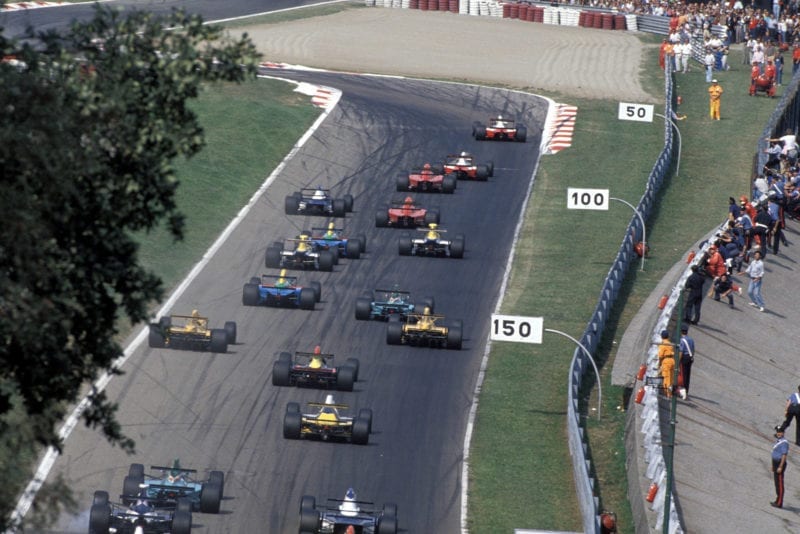
The field heads into turn one at the start
Motorsport Images
It is not difficult to see which teams know what they are doing, providing there is a good driver in the car, which is why the front-running teams are always up at the front. Friday morning was no exception and for a long time Jean Alesi was heading the times with his Tyrrell 019, its Brian Hart built Cosworth DFR pushing the slim Tyrrell through the air virtually as quick as the Honda, Ferrari and Renault powered cars. Monza being virtually flat there was no great advantage to the extra “grunt” of the more powerful engines. Just when it looked as if Alesi was going to head the morning testing times at 1 min 24.1 sec, Senna went out with the McLaren-Honda in “high-speed” trim, having been doing “race-trim” experiments and testing, and put in one fast lap to keep everything in perspective. His time was 1.23.6 sec! Not everything was plain sailing, for afterwards Mansell’s Ferrari and Donnelly’s Lotus arrived back at the pits on the end of tow-ropes.
From 1pm until 2pm the serious business of qualifying began, watched by a surprisingly large crowd who had the benefit of huge Star Vision screens at strategic points around the circuit which relayed TV pictures and times as they were happening, so that everyone could “live” with each driver on a fast qualifying lap. In the pits the Olivetti/Longines VDUs provided continuous data in figures to enable anyone to follow a driver’s progress, while Honda, Ferrari, Renault and Ford engineers were following the progress of their engines through the telemetry fitted to the cars sending information back to their control centres. At times you wonder if anyone is actually watching the driver at work!
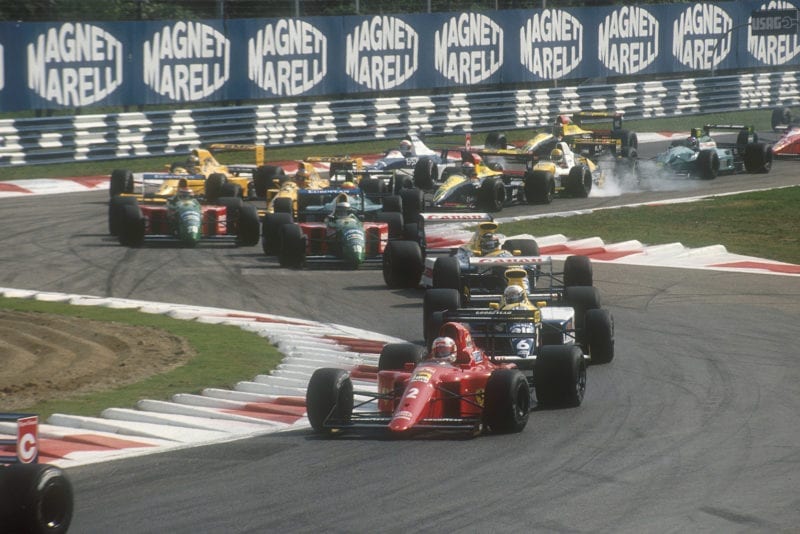
Nigel Mansell leads the rest of the field out of the first chicane
Motorsport Images
Qualifying was a clear tight battle between McLaren and Ferrari, or Honda and Fiat, with Senna and Berger versus Prost and Mansell. The quick morning lap by Senna showed that times in the 1 min 23 sec bracket were going to be called for, which was a world apart from most of the other runners, especially those at the back of the grid who were doing their best to record 1 min 28 secs, which looked like the cut-off point for the four drivers who were going to get left out. Senna went out quite early and set a benchmark of 1.23.704 and ten minutes later Berger upped this to 1.23.430. Mansell could only (only?) manage 1.23.892 and Prost a “slow” 1.24.806. However, the Frenchman then went for his second run and scored 1.23.497 which spurred Berger on to greater things and he recorded 1.23.239. Mansell replied with a lap at 1.23.141 and temporary pole position, amid shrieks of delight from the partisan crowd. Meanwhile Senna was waiting and watching, and when they had all done he went out and recorded 1 min 22.972! The looks on faces all along the pit lane, and the shaking of heads, were saying “How does he do it?” Senna knows how he does it, of that there is no doubt at all. It was interesting that the speed-trap over the finish line had Senna’s McLaren at 195.76 mph, slower than Berger, Prost, Mansell and Alesi, the number two McLaren recording 198.10 mph. More significant were the speeds through the “trap” out of the Curva Grande because there Senna was fastest.
Nobody else got below 1 min 24 sec and there was exactly six seconds difference between Senna’s fastest lap and that of the car in 30th position, the Coloni-Cosworth DFR of Gachot. It may be depressing for the majority of the entry, but this is Grand Prix racing, not an old ladies tea party or a sporting club affair.
While Friday had gone very much as anticipated, especially for the McLaren-Honda team, Saturday morning saw a complete reversal and while it would be untrue to say the red and white pits were in a panic, there was some pretty intense work going on and nobody had time for conversation. The morning test sessions which well organised teams use for deciding on a race set-up, checking fuel consumption, tyre wear, handling with full and near-empty fuel tank, all related to the track conditions, with a modicum of inspiration thrown in to allow for afternoon rise in the temperature, saw the Honda team in trouble. Senna had barely set off from the pits when his engine telemetry told the Honda engineers that all was not well. He was instantly back in the pits and as the impending trouble was not of a simple nature the decision was taken to change the engine.
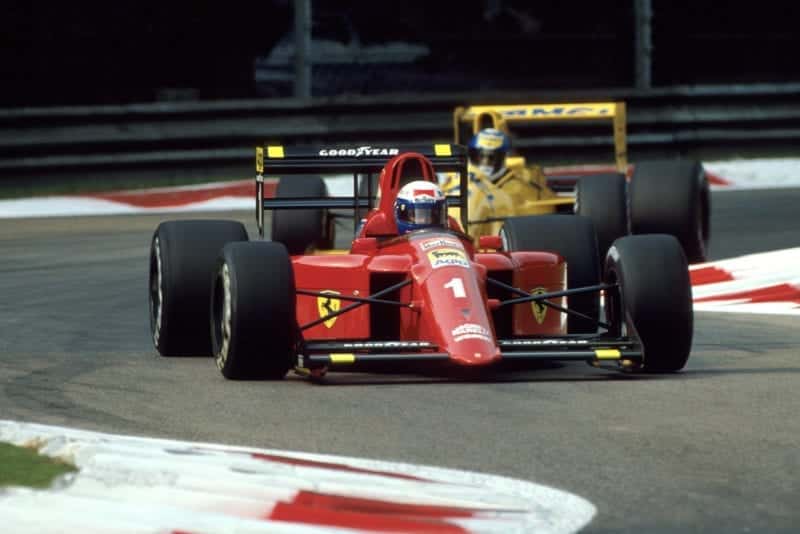
Alain Prost in his Ferrari
Motorsport Images
By pre-arranged planning the spare McLaren was for the priority use of Berger for this meeting, only available to Senna in emergency, so it was prepared for the Austrian’s size and driving style. Before Senna could use it many things had to be changed, so while one group of McLaren and Honda mechanics were taking the engine out of Senna’s car another group were altering the spare car. Meanwhile practice was continuing unabated and Berger was fending off competition from the Williams-Renaults, the Benettons and others, while Prost and Mansell were quietly getting on with race preparation. By the time Senna got out in the spare car time was running out and he only managed a total of eight laps, during which there was not much opportunity to make any real decisions about race set-up. During the morning most people had done more than 20 laps, and some nearer 30 laps in their search for optimum settings for race conditions.
As always the final qualifying hour began at 1pm on Saturday afternoon in fine and warm conditions, with a crowd of 40,000 having flooded into the Autodromo from early morning. Senna’s racecar was still being finished off and the Brazilian was standing quietly at the back of the workshop totally calm and composed, and in the meantime Berger went out on the track quite early “to hold the fort”, which he did valiantly. He recorded a 1.23.025 which kept him in second place behind Senna’s Friday time and when Prost and Mansell went out for their first runs and recorded 1.23.475 and 1.23.720 respectively, things were looking good for the McLaren team. Just before the Ferraris went out Senna’s car was finished and he did one quiet warming-lap and returned to the pits for minor adjustments.
Prost then pulled out all the stops and at his brilliant best did a lap in 1.22.935 to claim pole position by mere hundredths of a second, but pole position nonetheless. The noise from the crowd nearly drowned the passing cars. Senna now went out for another “test” lap, returning to the pits without completing a flying timed lap, and sat waiting, confident that now all was well. Berger went out for his second attempt and did an heroic 1.22.936, just one-thousandth of a second slower than Prost. (If you pause to contemplate the accuracy of the Longines/Olivetti timing system, you take away all the excitement.)
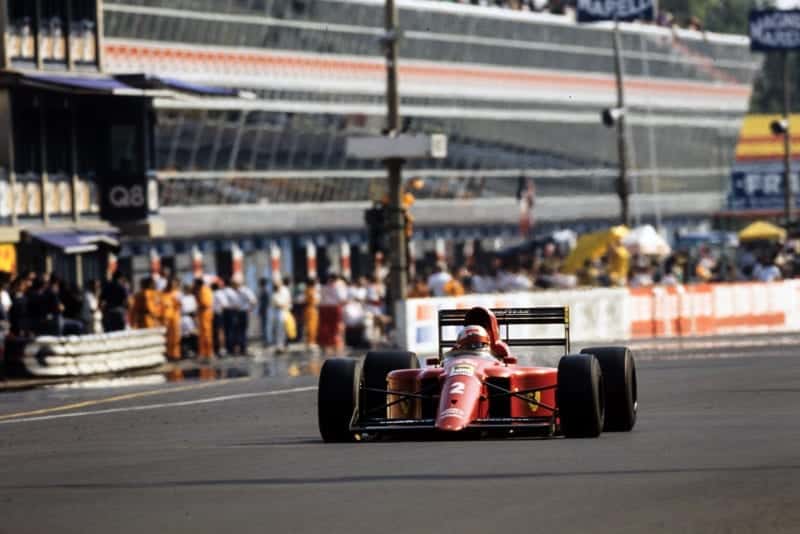
‘Il Leone’, Nigel Mansell
Motorsport Images
Senna was now in third place, with his Friday time of 1.22.972 and with less than four minutes left before the session ended McLaren number 27 trickled quietly down the pit lane and cut onto the track. As he went through to start his flying lap the chequered flag was being unfurled to mark the end of qualifying. Next time Senna went across the timing strip the digital timer stopped at 1 min 22.333 sec and an air of total incredulity wafted up and down the pit lane. Mere seconds after he had crossed the line the chequered flag came out to denote the end of qualifying. Not only had Senna snatched pole position back with seconds to spare, he had done so by nearly half a second, and with only one flying lap for the whole session. But what a lap! Within the vast crowd of spectators there were a lot of Brazilians, and they had formed a solid united section in the grandstand opposite the McLaren pits, and they took great delight in letting the world know where they were.
Personally I could have packed my bag there and then and returned home for anything else was going to be an anticlimax and a mere formality, but enthusiasm for racing still makes me stay until the last racing engine is switched off and the car packed away, to race another day.
Sunday was another fine day and from early morning the crowds poured into the circuit, for though McLaren-Honda had beaten Ferrari in the free-for-all of one lap qualifying sprints, they had yet to win the race and Prost had shown that he was not going to give in. In the McLaren team there had been long hours of decision-making in consultation with Honda and Goodyear, to decide on the detail settings of Senna’s car for race conditions. They had much testing data at their command and Senna and his engineers had done a lot of deep thinking and decision-making to set the car up, with only the early morning half hour “warm-up” period to cross-check their decisions. Yet again, Prost and Senna, Ferrari and McLaren, Fiat and Honda, were in a class of their own, with mere hundredths of a second between them at the end of “warm up” so clearly the McLaren decision-making was not far out.
The start of the 53 lap race was scheduled for 3pm, by which time the Autodromo had at least 100,000 people packed into it and the sun was shining and all was set for a good race. The 26 starters gradually took up their positions on the starting grid, as shown in the accompanying table, and the four non-qualifiers, Tarquini (AGS), BariIla (Minardi), Brabham (Brabham) and Gachot (Coloni) could only watch and hope that their turn would come in due course.
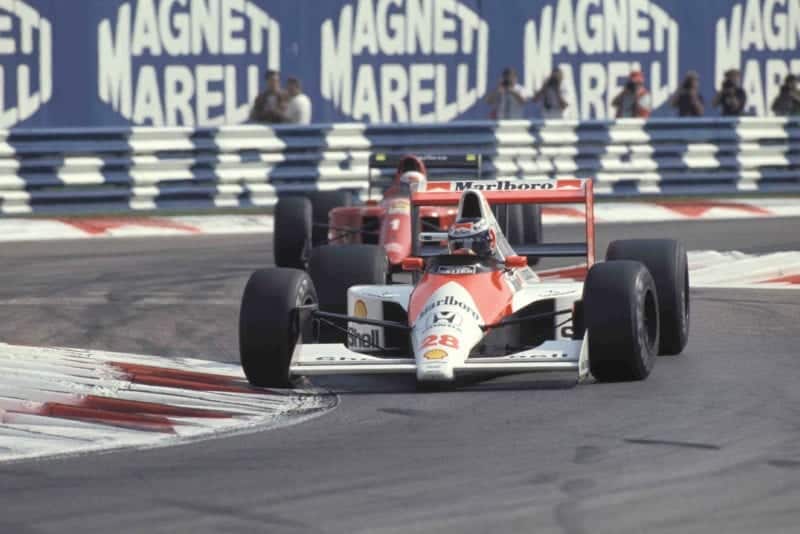
Prost chases down Gerhard Berger
Motorsport Images
The two McLarens were one behind the other on the left of the grid, and the two Ferraris were one behind the other on the right of the grid, with Alesi, in fifth place, behind the McLarens. That fact in itself was an embarrassment to the Williams-Renault team, the Benetton-works Cosworth team, the Leyton House-works Judd team and the four Lamborghini powered cars, two Lotus and two Lola. Away from the start, after the parade lap, it was even more embarrassing for Alesi went off the line like a rocket and was in behind the two McLarens almost before Prost or Mansell saw him. At the end of the opening lap it was Senna, Berger, Alesi, Prost, Mansell and just as we were wondering if we had been “seeing things” there was excitement down at the exit of the last corner leading onto the start/finish straight. Derek Warwick lost control of his Lotus, hit the outside barriers and rolled over and over, bits of the car flying off as it went, dissipating the kinetic energy. After a long time sliding along the track upside down the monocoque chassis came to rest in the middle of the track and Warwick scrambled quickly out, totally unhurt. Red flags stopped the race and there was a twenty minute delay while order was restored. Which time Warwick ran back to the pits and took over the spare Lotus-Lamborghini, taking it all in his stride as “part of motor racing” and passing a medical check by Professor Watkins with no problems.
At the re-start Prost kept a wary eye on Alesi and beat him into the first chicane, so it was McLaren, McLaren, Ferrari, Tyrrell with Senna in the lead again. Half way round that opening lap Alesi outbraked Prost into a chicane and snatched third place. The sheer audacity of the young Frenchman astounded everyone, most of all Alain Prost, who afterwards said he had never seen anyone brake so late and get away with it!
Senna was setting the pace from the front, with Berger following dutifully, but the blue and white Tyrrell number 4 was hanging on; not just for the opening lap, but throughout lap 2 and it was still there on lap 3 and lap 4. It could not in all truth go on like this. As the leaders braked into the first chicane on lap 3 the Tyrrell overdid it and got sideways on and then spun off the track into the loose run-off area, stopping within inches of the barriers, and that was that. Alesi had gone out in a blaze of glory, and while some of his critics derided him as a “hot-head” there were those who appreciated the many good things about this quiet young Frenchman.
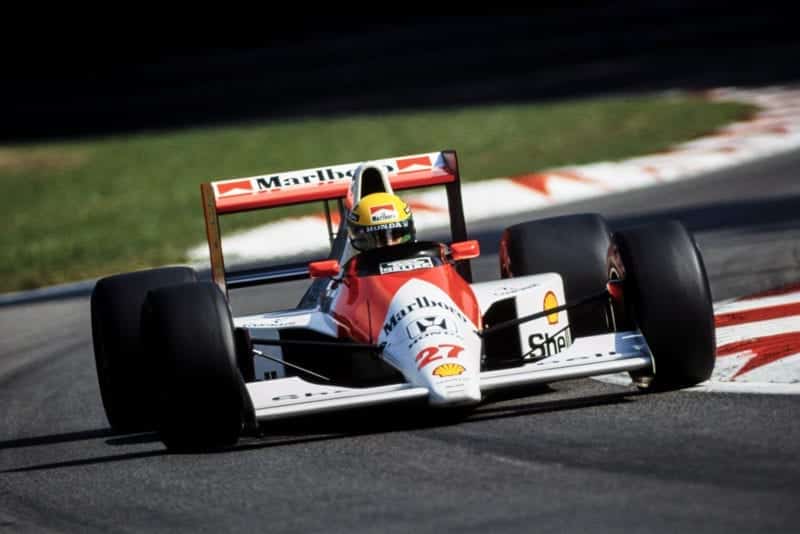
Senna out in front and leading
Motorsport Images
Once the excitement of the opening phase had died down Senna gradually dominated the scene, running the race at his own pace and pulling away little by little. At 10 laps Prost was beginning to press Berger and at that point Senna could see the tail-enders ahead of him. He then pushed” hard for a few laps, to open out a gap between himself and Berger and Prost, in readiness for lapping the slower cars, at the time deciding just where he was going to pass them, without losing time. His mental processes for doing this while racing at 145 mph average speed are remarkable.
Up to this point in the race the fastest lap had been kicked around by Senna, Berger, Alesi, Prost, Nannini and Mansell in the general free-for-all while the race was settling down. But that now stopped and Senna made fastest lap on laps 14, 16, 19, 25 and 27, going faster and faster all the time. He was lapping the likes of Alliot, Larini, Modena, Grouillard, de Cesaris and Alboreto losing virtually no time at all. Behind him Berger and Prost were into the “traffic”, but Berger was not over-confident of his brakes and Prost took advantage and got by into second place, but Senna was long gone.
Mansell in the second Ferrari was not in the picture, having trouble with a slow-closing throttle mechanism, which at times he had to help by hooking his foot under the pedal, so he had little option other than to run a dispirited 4th. By this time both Lotus 102 cars had disappeared, Donnelly in a cloud of smoke from the engine and Warwick with clutch failure, while Martini, Bernard and Pirro had retired with mechanical failures, and Boutsen soon joined them.
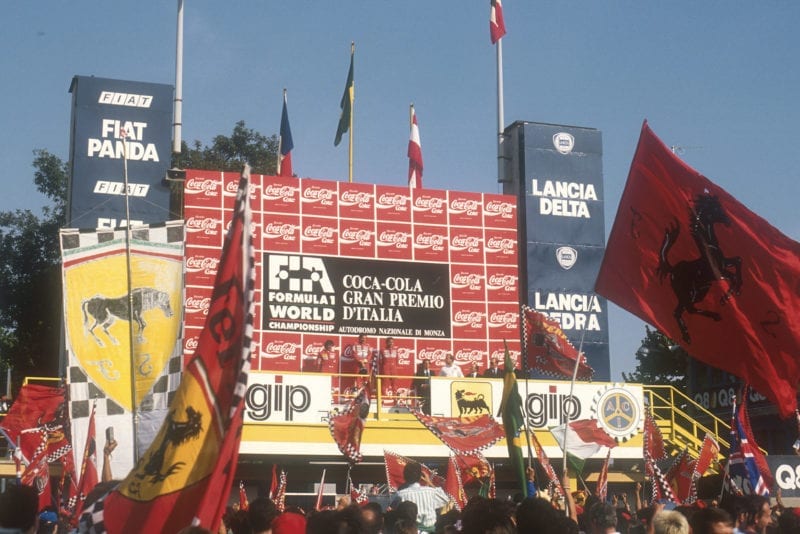
The top three stand on the podium above the rabid Tifosi
Motorsport Images
Senna now ran the race as he liked, and there was nothing Prost or the Ferrari could do about it; between them they traded fastest laps, but as soon as Prost put in a new one Senna counteracted it with a faster one. However, Prost was not giving up and the two of them kept at it right to the end the gap varying from 12 seconds to 5 seconds, but at no time was Senna troubled; he was in complete control of the race “from the front” and six seconds separated the McLaren and the Ferrari at the end of the race. The rest simply could not match the pace set by the “giants” of Formula One, whether we look upon them as Senna/Prost, McLaren/Ferrari or Honda/ Fiat, the result is the same.
The Benetton-Cosworth team were right out of the picture, in 7th and 8th places through no real fault of their own, for Nannini came in for a new set of tyres and had to stop his engine due to the clutch not freeing properly, and in the middle of the activity Piquet arrived unexpectedly with a deflated tyre. In the confusion both stops were so long that when they rejoined the race there was no hope of getting back up into the first six. This confusion let Nakajima take 6th place, the Japanese Tyrrell driver having driven a very good race and justifiably gaining himself another whole Championship point. Watching the Japanese Footwork owned Arrows team finishing 2 laps behind (Caffi) and 3 laps behind (Alboreto), using similar obsolete Cosworth DFR engines to the Tyrrell team, it causes some puzzlement over 1991. They are due to have the new Porsche-designed Formula One engine, which has simply got to be a competitor to the Honda, Ferrari, and Renault engines.
The 95,000 Ferrari fans (there must have been 5000 Ayrton Senna fans at the race) went home fairly subdued, having arrived hoping to see a Ferrari win, or at least a Ferrari leading at sometime. But they were not totally disappointed because Ferrari had achieved an honourable second place, which no other team could claim.
The Italian Grand Prix gave Senna his first win at Monza, his 26th Grand Prix victory, his 49th pole position and he set a new lap record and a new race record for the present-day circuit and led from start to finish. Not a bad weekend’s work in spite of a certain amount of trouble. DSJ
